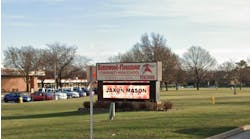On most college and university campuses, the fire-alarm setup typically comprises either a number of standalone building fire-alarm systems of various vintages, or an outmoded, inefficient hardwired monitoring system. In either case, upgrading the fire-safety system to a modern addressable campuswide system will increase its speed, reduce response time and improve maintenance. As a result, an institution will benefit from enhanced life safety and property protection, and reduced liability.
A number of cost-effective approaches are available for upgrading an existing system to a campuswide addressable network. Mapping out the best route requires an understanding of the existing technology and campus infrastructure, the campus master plan, and the codes and standards that apply in the local jurisdiction.
From standalone to street-box systems
The majority of campuses have a collection of protected-premises (local) fire-alarm systems — standalone units designed to protect a single structure — that were installed as buildings were built or acquired. In some cases, these have been hardwired into a campuswide monitoring system.
These older systems use a McCulloh circuit, a campuswide loop of standard, high-voltage paired copper wire cable that runs either underground or overhead, connecting all of the protected-premises fire-alarm systems to one monitoring system. McCulloh circuits operate on a principle similar to the old municipal fire-alarm systems, also known as street-box systems, in which each pull box in the system generates a series of audible rings whose pattern identifies the street box or building in which the alarm is sounding.
In the mid-1970s, the introduction of low-voltage multiplex technology improved the communications capabilities of campuswide fire-alarm systems. Nevertheless, the multiplex systems remain relatively slow, and, like the original protected-premises and hardwired monitoring systems, they cannot pinpoint the source of an alarm.
Many of the older, inefficient field devices also are still in place. This inevitably means response delays. Moreover, these systems are becoming increasingly difficult to maintain as manufacturer support and replacement parts become scarce.
Modern networked/addressable systems
With the development of networked/addressable fire-alarm systems in the early 1990s, the location of the fire alarm is automatically pinpointed at the building control panel. This can greatly enhance response time. Addressable building fire-alarm systems also incorporate intelligent field devices, which are more sensitive and accurate than most devices in place today.
Intelligent smoke detectors, for example, not only are much more sensitive to low levels of smoke, but also distinguish between smoke and common causes of false alarms, such as dust and steam. False alarms have been reduced by more than 50 percent with the use of intelligent addressable systems.
Today's fire protection for the campus environment comprises addressable fire-alarm systems and intelligent field devices installed in each campus building and networked into a proprietary supervising station fire-alarm system, one that is monitored continuously by trained personnel from a central location. The benefits of a campuswide addressable system are communication speed, pinpoint accuracy and enhanced response time, all of which have the potential to save lives and reduce property damage. The other benefit is improved system maintenance, including the ability to diagnose and repair problems from a central location, as well as the availability of manufacturer support and replacement parts.
Networked addressable fire-alarm systems use either of two types of communication media. An RS-485 network uses a single pair of copper wires to connect multiple buildings' addressable fire-alarm systems on one network. Fiber-optic cable, which is used extensively in telecommunications and data applications, now is being used to network fire-alarm systems.
The choice depends on site conditions, including whether there is an existing utility trench, environmental conditions within an existing trench system (i.e., copper fares poorly in a damp environment), and availability of spare capacity on an existing fiber-optic network, as well as the institution's master plan (i.e., if fiber-optic telecommunications networking is planned, allow spare capacity for fire-alarm and life-safety systems).
Planning ahead
Education institutions are taking various approaches to upgrading their older standalone or hardwired fire-alarm systems. If an institution is performing systematic campuswide interior renovations, then replacement of protected-premises systems with addressable building fire-alarm systems can be part of a cost-effective overall construction program. A building upgrade to an addressable system requires installation of new field devices and an addressable control panel. Existing building fire-alarm wiring may be able to be reused, depending on its age and the manufacturer. This is good news because the cost of rewiring is usually five times the cost of the equipment.
The institution also must consider its fire and security operations: Is there a fire brigade or security force at the university that is trained in responding to fire alarms, or does the local fire department respond to alarms? If the university performs that task, then it is beneficial to consider installing a campuswide monitoring system that monitors every building.
Since September 11
Fire-alarm installations are driven by codes developed by the National Fire Protection Association (NFPA) and the local jurisdiction. NFPA 101, the starting point, defines building occupancies and directs the owner to the proper code section for those occupancies. If the building is required to have a fire-alarm system, NFPA 72, the fire-alarm code, provides the general requirements for fire-alarm systems in buildings of various types. The local jurisdiction is the final authority, determining the applicable sections of the NFPA codes.
Providing a secondary control room has been a driving factor in many fire-alarm upgrades since 2001. Prior to the tragic events of September 11, 2001, NFPA had required campuswide networks to terminate in a single supervisory control room to ensure a uniform response to fire alarms. Since that time, NFPA's codes have been amended to ensure survivability; that is, if a control panel is either unattainable under certain conditions or if it fails, there must be an alternate location from which to maintain operations. Safeguards are built into the system to prevent two control locations from being active at the same time.
Sidebar: Three campuses, three different approaches
Three different campuses illustrate a variety of cost-effective approaches to upgrading to a campuswide fire-alarm system.
A 14-building campus with an existing McCulloh system upgraded the protected-premises system in each building with addressable devices and panels, reusing the McCulloh circuit as an RS-485 circuit among the buildings. This was accomplished by reconfiguring the wiring, removing the McCulloh transmitters, and providing two control stations. This solution provided point identification of every device in the system.
An eight-building campus with building fire-alarm systems of various vintages but without a campus monitoring system left the existing building systems in place. An ancillary fire-alarm monitoring system comprising RS-485 wiring installed in an existing tunnel system to network all buildings was installed. As interior renovations take place and the budget allows, each building system is replaced with an addressable system and is connected to the RS-485 network.
A 70-building campus with an existing campuswide McCulloh system is installing a campuswide fiber-optic network with supervising stations at three locations. The 10-year plan provides for systematic replacement of each building fire-alarm system and its reconnection to the new fiber-optic network. Meanwhile, the two systems operate independently. Once the last system comes off the McCulloh network, the McCulloh system will be decommissioned.
A college or university can implement a cost-effective upgrade of an existing fire-alarm system into a modern, campuswide addressable network through skillful planning — including phasing and reuse of existing infrastructure, wherever possible. The benefits of pinpoint identification, faster response, improved maintenance and reduced liability are too powerful to pass up.
Carrigan is associate partner/supervising engineer for fire/life safety in the New York City office of Syska Hennessy Group, a consulting, engineering, technology and construction firm that provides technical solutions in such areas as building system design, facilities management, energy management, technology consulting/engineering and turnkey design/build services.
